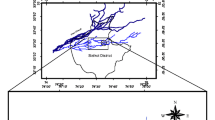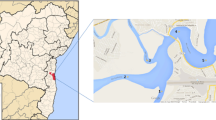Abstract
The aim of this study was to elucidate the seasonal and spatial regularity of the properties of metallothioneins (MTs) from the liver and kidney of the frog Rana ridibunda in rural (R) and urban (U) sites in Western Ukraine. This allowed examination of their possibility use in biomonitoring of environmental quality. The positive correlation for Zn and negative correlation for Cu were reflected between their content in the liver and MTs. The content of MTs was higher in summer compared to other seasons and also at the U site compare to the R site. MTs had been comprised of two chromatographic forms (MT-1 and MT-2/MT-2a), with lesser and variable MT-2/2a in frogs from the U site, particularly in the kidney. MTs accumulated about 75% of Cd in the liver. In summary, the ability MTs to elevate content as a stress response, together with the sensitivity of MT-2, may be explored to understand the health status of the frog in each season, reflecting the higher overall anthropogenic impact at the U site.




Similar content being viewed by others
References
Baranowska I (1995) Lead and cadmium in human placentas and maternal and neonatal blood (in a heavily polluted area) measured by graphite furnace atomic absorption spectrometry. Occup Environ Med 52:229–232
Brouwer M, Enghild J, Hoexum-Brouwer T, Thogersen I, Truncali A (1995) Primary structure and tissue-specific expression of blue crab (Callinectes sapidus) metallothionein isoforms. Biochem J 31:617–622
Cavaletto M, Ghezzi A, Burlando B, Evangelisti V, Ceratto N, Viarengo A (2002) Effect of hydrogen peroxide on antioxidant enzymes and metallothionein level in the digestive gland of Mytilus galloprovincialis. Comp Biochem Physiol 131C:447–455
Chen P, Onana P, Shaw CF, Petering DH (1996) Characterization of calf liver Cu, Zn-metallothionein: naturally variable Cu and Zn stoichiometries. Biochem J 317:389–394
Coyle P, Hubert CA, Philcox JC, Rofe AM (2001) Importance of storage conditions for the stability of zinc- and cadmium-induced metallothionein. Biol Trace Elem Res 81:269–278
Dallinger R, Berger B, Gruber C, Stürzenbaum S (2000) Metallothioneins in terrestrial invertebrates: structural aspects, biological significance, and implications for their use as biomarkers. Cell Mol Biol 46:331–346
Das K, Debacker V, Bouquegneau JM (2002) White-sided dolphin metallothioneins: purification, characterisation and potential role. Comp Biochem Physiol 131C:245–252
Dobrovoljc K, Falnoga I, Bulog B, Tusek-Znidaric M, Scancar J (2003) Hepatic metallothioneins in two neotenic salamanders, Proteus anguinus and Necturus maculosus (Amphibia, Caudata). Comp Biochem Physiol 135C:285–294
Guevara-Ortiz JM, Omar-Castellanos V, Leon-Chavez BA, Achanzar WE, Brambila E (2005) Interferon alpha induction of metallothionein in rat liver is not linked to interleukin-1, interleukin-6, or tumor necrosis factor alpha. Exp Mol Pathol 79:33–38
Handy RD (2003) Chronic effects of copper exposure versus endocrine toxicity: two sides of the same toxicological process? Comp. Biochem Physiol 135A:25–38
Hansen BH, Rømma S, Garmo ØA, Olsvik PA, Andersen RA (2006) Antioxidative stress proteins and their gene expression in brown trout (Salmo trutta) from three rivers with different heavy metal levels. Comp Biochem Physiol 143C:263–274
Hogstrand C, Haux C (1991) Binding and detoxification of heavy metals in lower vertebrates with reference to metallothionein. Comp Biochem Physiol 100C:137–141
Kagi JHR, Schaffer A (1988) Biochemistry of metallothionein. Biochemistry 27:8509–8515
Kershaw WC, Klaassen CD (1992) Degradation and metal composition of hepatic isometallothioneins in rats. Toxicol Appl Pharmacol 112:24–31
Kito H, Ose Y, Mizuhira V, Sato T, Ishikawa T, Tazawa T (1982) Separation and purification of (Cd, Cu, Zn)-metallothionein in carp hepatopancreas. Comp Biochem Physiol 73:121–127
Klaassen CD, Liu J, Choudhuri S (1999) Metallothionein: an intracellular protein to protect against Cd toxicity. Annu Rev Pharmacol Toxicol 39:267–294
Lacorn M, Lahrssen A, Rotzoll N, Simat TJ, Steinhart H (2001) Quantification of metallothionein isoforms in fish liver and its implications for biomonitoring. Environ Toxicol Chem 20:140–145
Leiniö S, Lehtonen KK (2005) Seasonal variability in biomarkers in the bivalves Mytilus edulis and Macoma balthica from the northern Baltic Sea. Comp Biochem Physiol 140C:408–421
Loumbourdis NS, Wray D (1998) Heavy metal concentration in the frog Rana ridibunda from a small river of Macedonia, Northern Greece. Environ Int 24:427–431
Maret W (2000) The function of zinc metallothionein: a link between cellular zinc and redox state. J Nutrition 130:1455S–1458S
Monserrat JM, Martínez PE, Geracitano LA, Amado LL, Martins CMG, Pinho GLL, Chaves IS, Ferreira-Cravo M, Ventura-Lima J, Bianchini A (2007) Pollution biomarkers in estuarine animals: critical review and new perspectives. Comp Biochem Physiol 146C:221–234
Mosleh YY, Paris-Palacios S, Couderchet M, Biagianti-Risbourg S, Vernet G (2005) Effects of the herbicide isoproturon on metallothioneins, growth, and antioxidative defenses in the aquatic worm Tubifex tubifex (Oligochaeta, Tubificidae). Ecotoxicology 14:559–571
Muto N, Ren HW, Hwang GS, Tominaga S, Itoh N, Tanaka K (1999) Induction of two major isoforms of metallothionein in crucian carp (Carassius Cuvieri) by air-pumping stress, dexamethasone, and metals. Comp Biochem Physiol 122C:75–82
Nielson KB, Winge DR (1985) Independence of the domains of metallothionein in metal binding. J Biol Chem 260:8698–8701
Olsson PE, Hogstrand C (1987) Improved separation of perch liver metallothionein by fast protein liquid chromatography. J Chromatogr 402:293–299
Olsvik PA, Gundersen P, Andersen RA, Zachariassen KE (2000) Metal accumulation and metallothionein in two populations of brown trout, Salmo trutta, exposed to different natural water environments during a run-off episode. Aquat Toxicol 50:301–316
Papadimitriou EA, Loumbourdis NS (2003) Copper kinetics and hepatic metallothionein levels in the frog Rana ridibunda, after exposure to CuCl2. BioMetals 16:271–277
Paris-Palacios S, Biagianti-Risbourg S, Vernet G (2003) Metallothionein induction related to hepatic structural perturbations and antioxidative defences in roach (Rutilus rutilus) exposed to the fungicide procymidone. Biomarkers 8:128–141
Roesijadi G (1996) Metallothionein and its role in toxic metal regulation. Comp Biochem Physiol 113C:117–123
Rotchell JM, Clarke KR, Newton LC, Bird DJ (2001) Hepatic metallothionein as a biomarker for metal contamination: age effects and seasonal variation in European flounders (Pleuronectes flesus) from the Severn Estuary and Bristol Channel. Mar Environ Res 52:151–171
Rouhani Rankouhi T, Sanderson JT, van Holsteijn I, van Kooten P, Bosveld ATC, van den Berg M (2005) Effects of environmental and natural estrogens on vitellogenin production in hepatocytes of the brown frog (Rana temporaria). Aquat Toxicol 71:97–101
Smaoui-Damak W, Hamza Chaffai A, Bebianno MJ, Amiard JC (2004) Variation of metallothioneins in gills of the clam Ruditapes decussatus from the Gulf of Gabes (Tunisia). Comp Biochem Physiol 139С:181–188
Stolyar OB, Myhayliv RL, Mischuk OV (2005) The concentration-specific response of metallothioneins in copper-loading freshwater bivalve Anodonta cygnea. Ukr Biochim Zh 77:65–69
Stolyar OB, Loumbourdis NS, Falfushinska HI, Romanchuk LD (2008) Comparison of metal bioavailability in frogs from urban and rural sites of Western Ukraine. Arch Environ Contam Toxicol 54:107–113
Suzuki KT (1987) Quantification and characterization of metallothioneins in tissues of lower vertebrates and invertebrates. Experientia Suppl 52:265–272
Suzuki KT, Akitomi H, Kawamura R (1984) Cadmium, copper and zinc-binding protein (metallothionein) in the liver of the water lizard Triturus pyrrhogaster. Toxicol Lett 21:179–184
Suzuki KT, Itoh N, Ohta K, Sunaga H (1986) Amphibian metallothionein. Induction in the frogs Rana japonica, R. nigromaculata and Rhacophorus schlegelii. Comp Biochem Physiol 83C:253–259
Venturino A, Rosenbaum E, Caballero de Castro A, Anguiano OL, Gauna L, Fonovich de Schroeder T, Pechen de D’Angelo AM (2003) Biomarkers of effect in toads and frogs. Biomarkers 8:167–186
Vogiatzis A, Loumbourdis NS (1998) Cd accumulation in liver and kidneys and hepatic metallothionein and glutathione levels in Rana ridibunda, after exposure to CdCl2. Arch Environ Contam Toxicol 34:64–68
Wilhelmsen TW, Olsvik PA, Hansen BH, Andersen RA (2002) Evidence for oligomerization of metallothioneins in their functional state. J Chromatogr 979:249–254
Acknowledgments
This work has been granted by Ministry of Education and Science of Ukraine (Ukrainian-Greece scientific and technical cooperation joint Project #M-65/2006) and partly supported by West-Ukrainian BioMedical Research Center. The authors wish to thank Dr N. S. Loumbourdis for commenting and Dr P. Spearpoint for the linguistic and phraseological improvement of manuscript. The authors are grateful to Post graduated students O. G. Bazan, M. M. Guzik for animal collection.
Author information
Authors and Affiliations
Corresponding author
Rights and permissions
About this article
Cite this article
Falfushynska, H.I., Romanchuk, L.D. & Stolyar, O.B. Seasonal and spatial comparison of metallothioneins in frog Rana ridibunda from feral populations. Ecotoxicology 17, 781–788 (2008). https://doi.org/10.1007/s10646-008-0229-6
Received:
Accepted:
Published:
Issue Date:
DOI: https://doi.org/10.1007/s10646-008-0229-6




